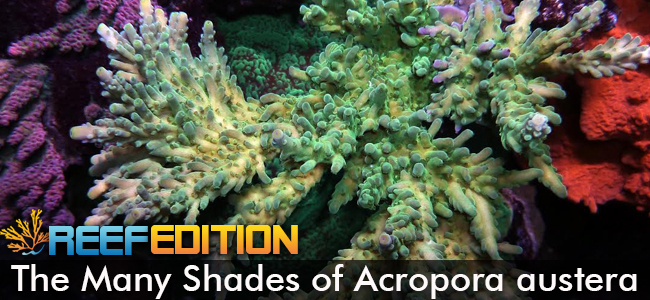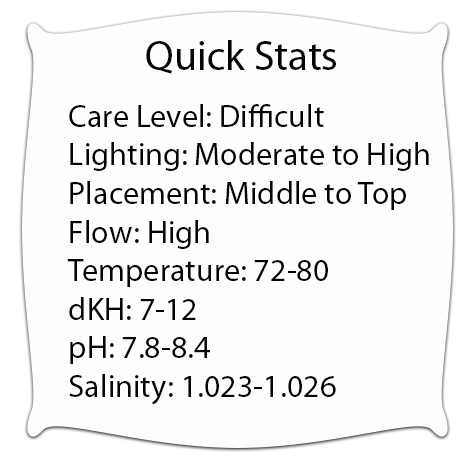SPS Spotlight: The Many Shades Of Acropora Austera

What’s not to like about an Acropora species that comes in many different variations of color and growth forms, is beautiful, and not too difficult to find? Acropora austera certainly fits that description coming in a wide range of color forms and shapes. It is a fast growing hermatypic (reef building) coral which forms a thick, tree-like structure. Main branches are frequently fused, usually curve away from each other and usually taper at the ends. This coral forms numerous sub-branches which vary in size and also taper. Axial corallites are thick walled with small openings. Radial corallites are irregular in size and may be arranged in rows. Larger radial corallites project outwards and have wide square-shaped openings. As mentioned, A. austera comes in many colors, most commonly blue, purple, green or cream. Axial corallites are frequently blue or yellow.1
Fig 1, immature A. austera colony

Natively, A. austera is predominantly found in the Indian and Pacific Oceans, Red Sea, and the East China Sea. It typically colonizes on upper and/or shallow reef slopes, and areas of high turbulence and wave action.2
A. austera is a fairly difficult SPS coral to keep. It requires stable, high-quality water parameters, high water flow, and strong lighting to thrive in captivity. We have found it to be highly photo-reactive, so it can dramatically alter its looks based on the amount and wavelengths of light it receives.3 While not common, A. austera can be found at most reputable local and online retailers specializing in SPS, and is fairly affordable.
Immature colonies of A. austera, like many other Acropora species, can show quite different coloration and growth forms than those of mature colonies. Take a look at Figure 1, which is a picture of an immature colony. Note the predominate yellow base coloration, and the lack of the distinctive fused, curving branches typical of the species. Figure 2 shows the same colony approximately 18 months later. This colony is still maturing, but already there is a wonderful emergence of several different colors, and the typical A. austera growth forms are apparent.
As with many Acropora species, A. austera can be misidentified or confused with other corals (particularly A. tortuosa). A well-known example would be Miyagi Tort. Regardless of what name you give them, austera corals are truly beautiful and can be a wonderful addition to your SPS or mixed reef aquarium.
Fig 3, twin young “migyagi Tort” colonies
Comments are closed.

